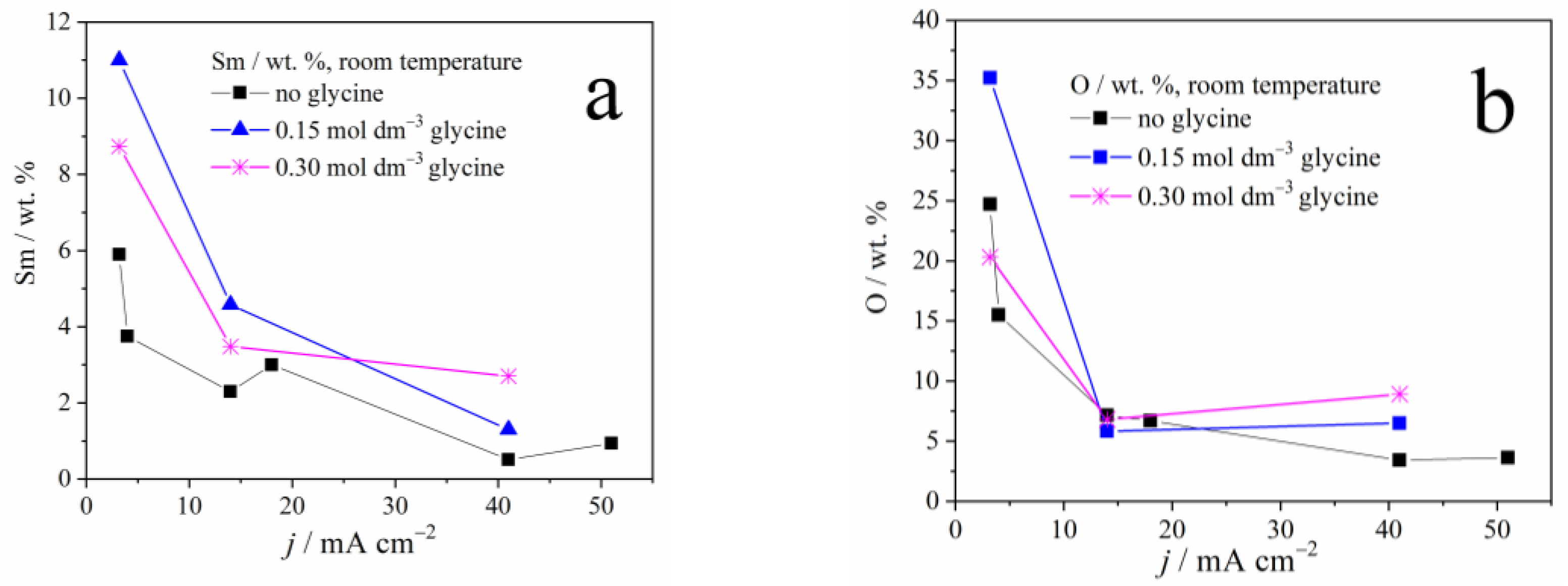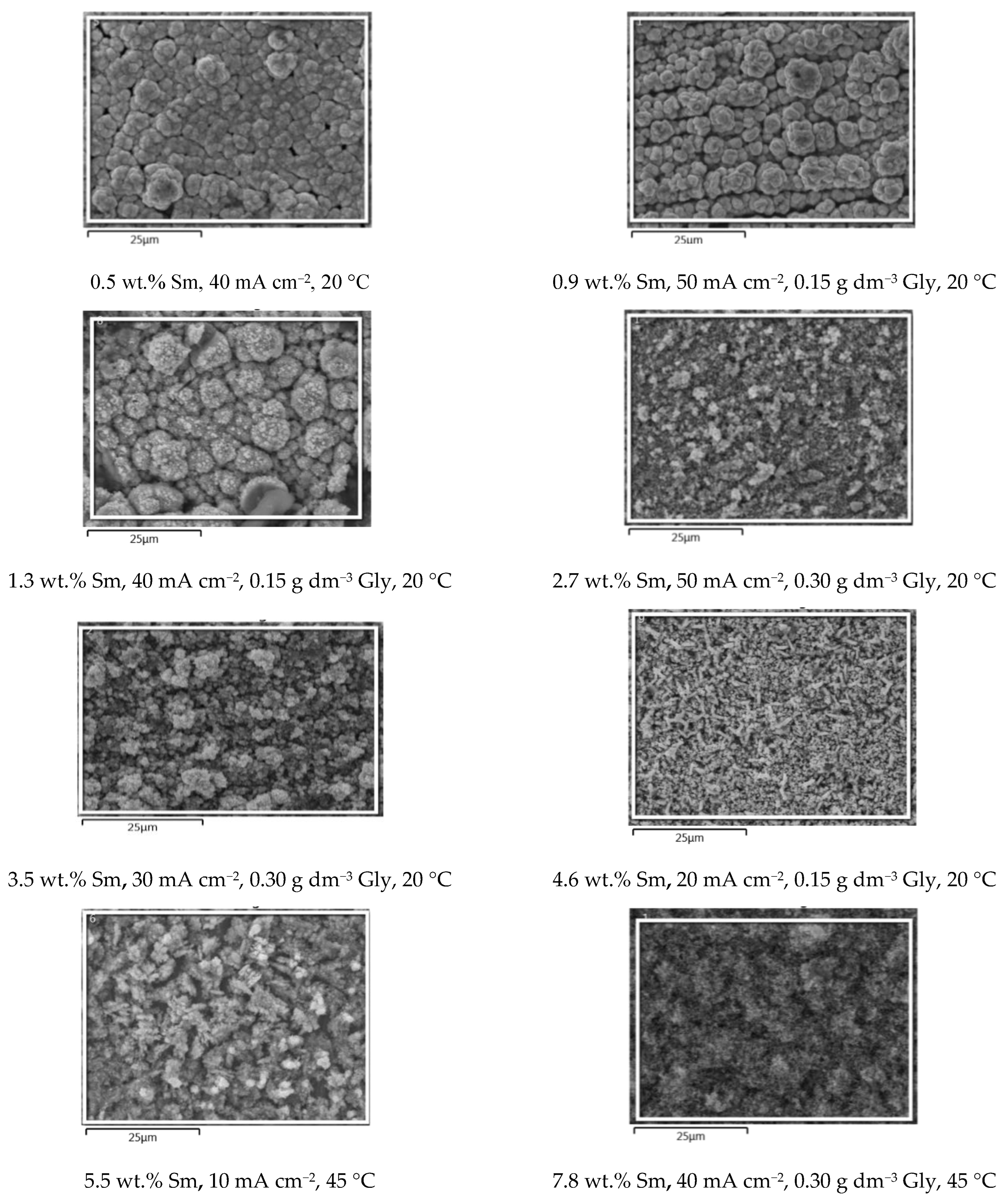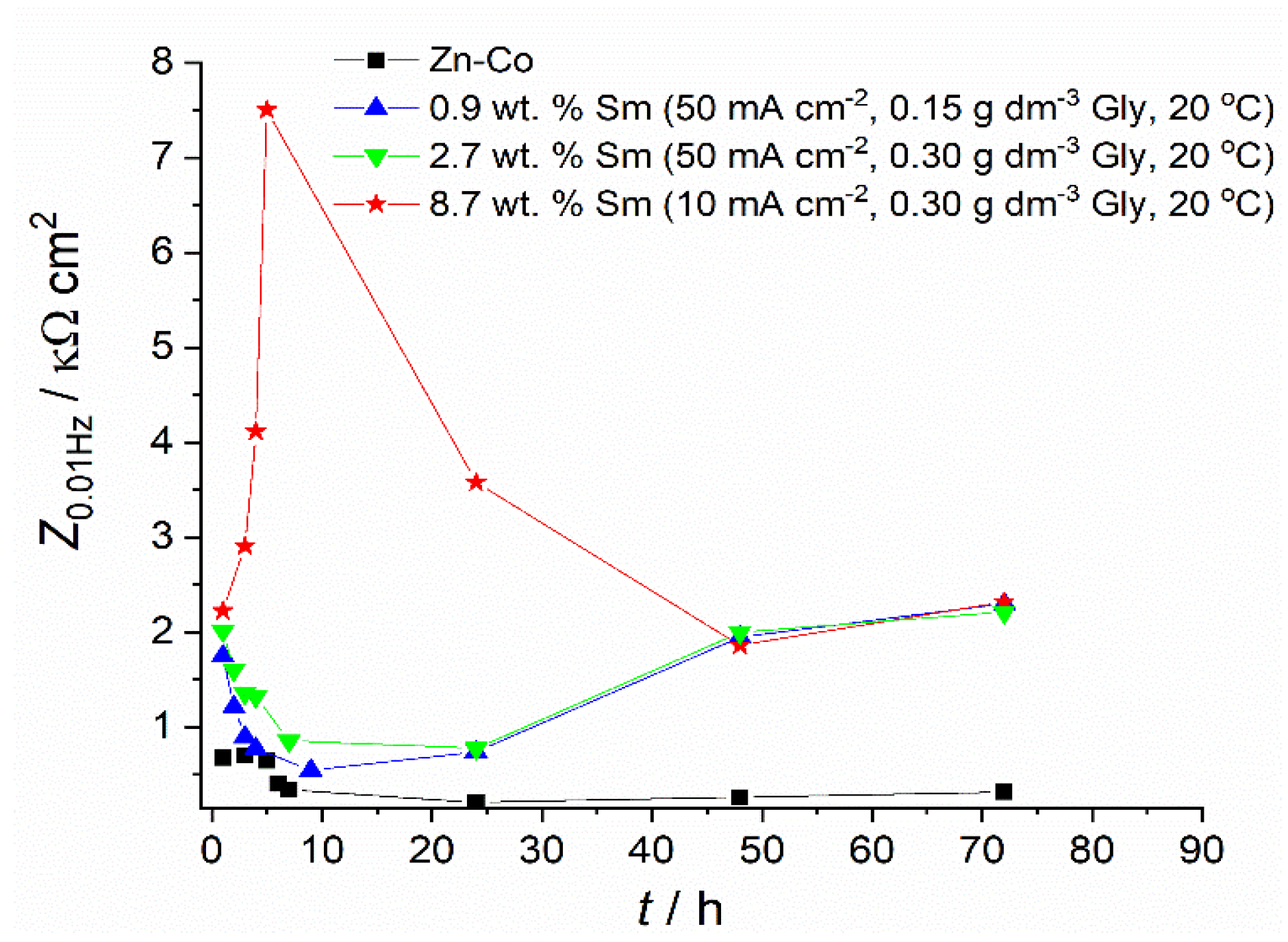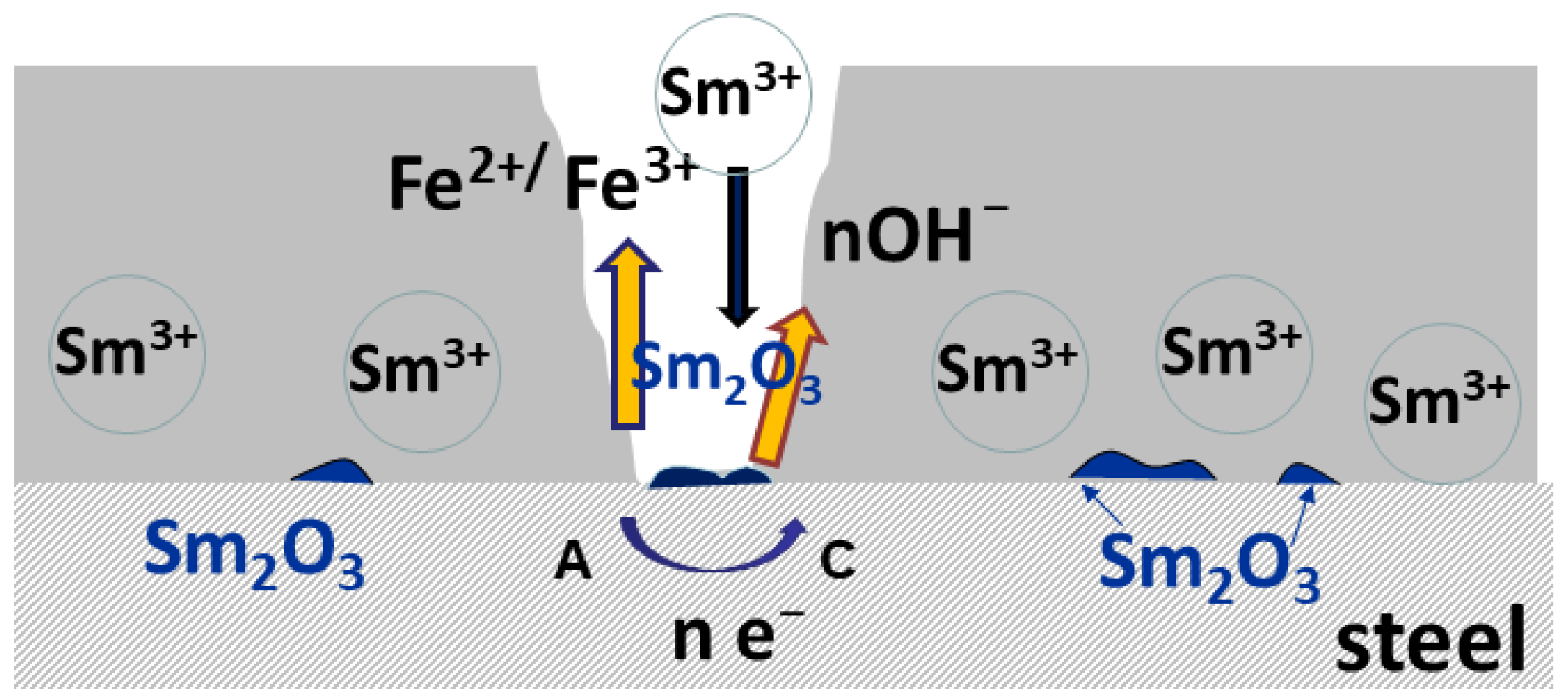The Influence of Sm Content on the Surface Morphology and Corrosion Behavior of Zn-Co-Sm Composite Coatings
Abstract
1. Introduction
2. Materials and Methods
2.1. Preparation of Zn-Co-Sm Coatings
2.2. Coating Characterization
3. Results and Discussion
3.1. Chemical Composition of Zn-Co-Sm Coatings
3.2. Coating Morphology and Surface Appearance
3.3. Phase Composition of the Coatings
 ) in all XRD patterns, owing to the formation of a solid solution of Co with Zn in Zn-Co coatings with less than 5% Co. The presence of Co and Sm caused changes in the crystal lattice which resulted in the shift of 2θ values. Namely, the peak at 36.435°, related to the (002) plane, in Zn-Co was shifted to 35.745° and 35.825° for composite coatings deposited at 5 and 15 mA cm−2, respectively. The peak at 70.254° in Zn-Co alloy coating diminished in composite coatings, whereas additional peaks emerged at 82.448° and 82.368°, related to the (112) plane.
) in all XRD patterns, owing to the formation of a solid solution of Co with Zn in Zn-Co coatings with less than 5% Co. The presence of Co and Sm caused changes in the crystal lattice which resulted in the shift of 2θ values. Namely, the peak at 36.435°, related to the (002) plane, in Zn-Co was shifted to 35.745° and 35.825° for composite coatings deposited at 5 and 15 mA cm−2, respectively. The peak at 70.254° in Zn-Co alloy coating diminished in composite coatings, whereas additional peaks emerged at 82.448° and 82.368°, related to the (112) plane. ) have been indexed as the cubic Sm2O3 phase. Six diffraction peaks are detected at diffraction angles of 27.16, 31.15., 32.80, 40.98, 56.36, and 60.40°, corresponding to the plane orientation (100), (101), (400), (102), (200), and (004), respectively. The Sm2O3 crystalline phase has been obtained by electrodeposition and reported by other researchers as well [27]. The identification of the Sm2O3 phase confirms the proposed mechanism for the Sm inclusion in the coating: Sm3+ ions are transferred to the cathode; the pH increase occurs due to the oxygen reduction reaction; Sm(OH)3 species are formed and irreversibly adsorbed on the cathode surface [28] and occluded by the reduced metal atoms, and the oxide particles are formed upon the subsequent hydroxide dehydration.
) have been indexed as the cubic Sm2O3 phase. Six diffraction peaks are detected at diffraction angles of 27.16, 31.15., 32.80, 40.98, 56.36, and 60.40°, corresponding to the plane orientation (100), (101), (400), (102), (200), and (004), respectively. The Sm2O3 crystalline phase has been obtained by electrodeposition and reported by other researchers as well [27]. The identification of the Sm2O3 phase confirms the proposed mechanism for the Sm inclusion in the coating: Sm3+ ions are transferred to the cathode; the pH increase occurs due to the oxygen reduction reaction; Sm(OH)3 species are formed and irreversibly adsorbed on the cathode surface [28] and occluded by the reduced metal atoms, and the oxide particles are formed upon the subsequent hydroxide dehydration.3.4. Corrosion Resistance of the Zn-Co-Sm Coatings
4. Conclusions
Author Contributions
Funding
Data Availability Statement
Acknowledgments
Conflicts of Interest
References
- Pushpavanam, M. Critical review on alloy plating: A viable alternative to conventional plating. Bull. Electrochem. 2000, 16, 559–566. [Google Scholar]
- Shears, A.P. Zinc-cobalt deposits from an acid chloride electrolyte. Trans. IMF 1989, 67, 67–69. [Google Scholar]
- Abibsi, A.; Short, N.R.; Dennis, J.K. The formation, structure and corrosion behaviour of conversion coatings on zinc alloy electrodeposits. Trans. IMF 1991, 69, 45–49. [Google Scholar] [CrossRef]
- Yuan, W.; Xia, D.; Wu, S.; Zhen, Y.; Guan, Z.; Rau, J.V. A review on current research status of the surface modification of Zn-based biodegradable metals. Bioact. Mater. 2022, 7, 192–216. [Google Scholar] [CrossRef]
- Stankiewicz, A.; Szczygieł, I.; Szczygieł, B. Self-healing coatings in anti-corrosion applications. J. Mater. Sci. 2013, 48, 8041–8051. [Google Scholar] [CrossRef]
- Carneiro, J.; Tedim, J.; Fernandes, S.C.M.; Freire, C.R.S.; Silvestre, A.J.D.; Gandini, A.; Ferreira, M.G.S.; Zheludkevich, M.L. Chitosan-based self-healing protective coatings doped with cerium nitrate for corrosion protection of aluminum alloy 2024. Prog. Org. Coat. 2012, 75, 8–13. [Google Scholar]
- Esser-Kahn, A.P.; Odom, S.A.; Sottos, N.R.; White, S.R.; Moore, J.S. Triggered Release from Polymer Capsules. Macromolecules 2011, 44, 5539–5553. [Google Scholar] [CrossRef]
- Wu, L.K.; Liu, L.; Li, J.; Hu, J.M.; Zhang, J.Q.; Cao, C.N. Electrodeposition of cerium (III)-modified bis-[triethoxysilypropyl]tetra-sulphide films on AA2024-T3 (aluminum alloy) for corrosion protection. Surf. Coat. Technol. 2010, 204, 3920–3926. [Google Scholar] [CrossRef]
- Rosero-Navarro, N.C.; Pellice, S.A.; Durán, A.; Aparicio, M. Effects of Ce-containing sol–gel coatings reinforced with SiO2 nanoparticles on the protection of AA2024. Corros. Sci. 2008, 50, 1283–1291. [Google Scholar] [CrossRef]
- Riđošić, M.; Bučko, M.; Salicio-Paz, A.; Garcia-Lecina, E.; Živković, L.J.; Bajat, J.B. Ceria particles as efficient dopant in the electrodeposition of Zn-Co-CeO2 composite coatings with enhanced corrosion resistance: The effect of current density and particle concentration. Molecules 2021, 26, 4578–4598. [Google Scholar] [CrossRef] [PubMed]
- Nemeş, P.I.; Zaharescu, M.; Muresan, L.M. Initial corrosion behavior of composite coatings obtained by co-electrodeposition of zinc with nanoparticles of Ti and Ce oxides. J. Solid State Electrochem. 2013, 17, 511–518. [Google Scholar] [CrossRef]
- Exbrayat, L.; Rébéré, C.; Ndong Eyame, R.; Steyer, P. Creus, Corrosion behaviour in saline solution of pulsed-electrodeposited zinc-nickel-ceria nanocomposite coatings. Mater. Corros. 2017, 68, 1129–1142. [Google Scholar] [CrossRef]
- Lopez, J.R.; Mendez, P.F.; Perez Bueno, J.J.; Trejo, G.; Antano, R.J.; Stremsdoerfer, T.G.; Meas, Y.G. Samarium additive effect onto the nickel electrodeposition process. J. Electrochem. Soc. 2017, 164, D524–D531. [Google Scholar] [CrossRef]
- Hasannejad, H.; Shahrabi, T.; Jafarian, M.; Rouhaghdam, A.S. EIS study of nano crystalline Ni-cerium oxide coating electrodeposition mechanism. J. Alloys Comp. 2011, 509, 1924–1930. [Google Scholar] [CrossRef]
- Xie, M.; Zhu, L.; Li, W.; Liu, H.; Zhang, T. Electrodeposition of Sm-Co alloy films with nanocrystalline/amorphous structures from a sulphamate aqueous solution. Int. J. Electrochem. Sci. 2017, 12, 11330–11342. [Google Scholar] [CrossRef]
- Jundale, S.B.; Lokhande, C.D. Studies on electrosynthesis of Sm-Se films. Mater. Chem. Phys. 1994, 38, 325–331. [Google Scholar] [CrossRef]
- Ruiz, E.J.; Borges, R.O.; Godinez, L.A.; Chapman, T.W.; Vong, Y.M. Mechanism of the electrochemical deposition of samarium-based coatings. Electrochim. Acta 2006, 52, 914–920. [Google Scholar] [CrossRef]
- Schwartz, M.; Myung, N.V.; Nobe, K. Electrodeposition of iron group-rare earth alloys from aqueous media. J. Electrochem. Soc. 2004, 151, C468–C477. [Google Scholar] [CrossRef]
- Riđošić, M.; Nikolić, N.D.; Salicio-Paz, A.; García-Lecina, E.; Živković, L.S.; Bajat, J.B. ZnCo-CeO2 vs. ZnCo coatings: Effect of CeO2 Sol in the Enhancement of the Corrosion Performance of Electrodeposited Composite Coatings. Metals 2021, 11, 704–723. [Google Scholar] [CrossRef]
- Zhitomirsky, I.; Petric, A. č Electrochemical deposition of yttrium oxide. J. Mater. Chem. 2000, 10, 1215–1218. [Google Scholar] [CrossRef]
- Harvey, T.G. Cerium-based conversion coatings on aluminium alloys: A process review. Corros. Eng. Sci. Technol. 2013, 48, 248–269. [Google Scholar] [CrossRef]
- Wei, J.C.; Schwartz, M.; Nobe, K. Aqueous electrodeposition of SmCo alloys I. Hull cell studies. J. Electrochem. Soc. 2008, 155, D660–D665. [Google Scholar] [CrossRef]
- Ortiz-Aparicio, J.L.; Meas, Y.; Trejo, G.; Ortega, R.; Chapman, T.W.; Chainet, E.; Ozil, P. Electrodeposition of zinc–cobalt alloy from a complexing alkaline glycinate bath. Electrochim. Acta 2007, 52, 4742–4751. [Google Scholar] [CrossRef]
- Bhat, R.; Hegde, A.C. Studies on electrodeposited Zn-Fe alloy coating on mild steel and its characterization. J. Electrochem. Sci. Eng. 2019, 9, 9–16. [Google Scholar] [CrossRef]
- Luo, G.; Yuan, Y.; Li, D.Y.; Li, N.; Yuan, G.H. Current transition of nucleation and growth under diffusion-controlled electrocrystallization: A brief review. Coatings 2022, 12, 1195–1209. [Google Scholar] [CrossRef]
- Riazaty, P.; Naderi, R.; Ramezanzadeh, B. Enhancement of the epoxy coating corrosion/cathodic delamination resistances on steel by a samarium based conversion coating. J. Electrochem. Soc. 2019, 166, C353–C364. [Google Scholar] [CrossRef]
- Lair, V.; Zivkovic, O.; Lupan, L.S.; Ringuedé, A. Synthesis and characterization of electrodeposited samaria and samaria-doped ceria thin films. Electrochim. Acta 2011, 56, 4638–4644. [Google Scholar] [CrossRef]
- Protsenko, V.S.; Danilov, F.I. Kinetic model of composite coatings electrodeposition assuming irreversible adsorption of dispersed particles on a growing metal substrate. J. Electroanal. Chem. 2022, 918, 116463. [Google Scholar] [CrossRef]
- Barranco, V.; . Feliu, S., Jr.; Feliu, S. EIS study of the corrosion behaviour of zinc-based coatings on steel in quiescent 3% NaCl solution. Part 1: Directly exposed coatings. Corr. Sci. 2004, 46, 2203–2220. [Google Scholar] [CrossRef]
- Bučko, M.; Rogan, J.; Stevanović, S.I.; Perić-Grujić, A.; Bajat, J.B. Initial corrosion protection of Zn–Mn alloys electrodeposited from alkaline solution. Corr. Sci. 2011, 53, 2861–2871. [Google Scholar] [CrossRef]
- Magalhães, A.A.O.; Margarit, I.C.P.; Mattos, O.R. Electrochemical characterization of chromate coatings on galvanized steel. Electrochim. Acta 1999, 44, 4281–4287. [Google Scholar] [CrossRef]
- Fratesi, R.; Roventi, G.; Branca, C.; Simoncini, S. Corrosion resistance of Zn-Co alloy coatings. Surf. Coat. Techn. 1994, 63, 97–103. [Google Scholar] [CrossRef]
- Zheludkevich, M.L.; Shchukin, D.G.; Yasakau, K.A.; Mohwald, H.; Ferreira, M.G.S. Anticorrosion Coatings with Self-Healing Effect Based on Nanocontainers Impregnated with Corrosion Inhibitor. Chem. Mater. 2007, 19, 402–411. [Google Scholar] [CrossRef]
- Orhanovic, Z.; Pokric, B.; Furedi, H.; Branica, M. Precipitation and Hydrolysis of Metallic Ions. III. Studies on the Solubility of Yttrium and Some Rare Earth Hydroxides. Croat. Chem. Acta 1966, 38, 269–276. [Google Scholar]
- De Lima-Neto, P.; Correia, A.N.; Colares, R.P.; Araujo, W.S. Corrosion Study of Electrodeposited Zn and Zn-Co Coatings in Chloride Medium. J. Braz. Chem. Soc. 2007, 18, 1164–1175. [Google Scholar] [CrossRef]












| Sample: 10 mA cm−2 Immersion Time (h) | Rs Ω cm2 | Rct Ω cm2 | CPE | Zw | ||
|---|---|---|---|---|---|---|
| Y0 10−6 S cm−2 sn | n | Y0 10−3 S cm−2 s1/2 | B s½ | |||
| 1 | 113 | 2223 | 504 | 0.71 | - | - |
| 3 | 143 | 3998 | 517 | 0.69 | - | - |
| 5 | 112 | 5994 | 492 | 0.61 | - | - |
| 24 | 103 | 3485 | 111 | 0.84 | - | - |
| 48 | 102 | 1982 | 139 | 0.85 | - | - |
| 72 | 108 | 2257 | 139 | 0.87 | - | - |
| Sample: 50 mA cm−2 Immersion time (h) | Rs Ω cm2 | Rct Ω cm2 | CPE | Zw | ||
| Y0 10−6 S cm−2 sn | n | Y0 10−3 S cm−2 s1/2 | B s½ | |||
| 1 | 198 | 1298 | 335 | 0.77 | 56.3 | 10.1 |
| 2 | 206 | 1210 | 415 | 0.81 | - | - |
| 3 | 212 | 706 | 501 | 0.83 | - | - |
| 4 | 211 | 566 | 432 | 0.91 | - | - |
| 9 | 201 | 403 | 443 | 0.95 | 44.8 | 14.2 |
| 24 | 199 | 692 | 478 | 0.79 | - | - |
| 48 | 186 | 2821 | 400 | 0.93 | - | - |
Disclaimer/Publisher’s Note: The statements, opinions and data contained in all publications are solely those of the individual author(s) and contributor(s) and not of MDPI and/or the editor(s). MDPI and/or the editor(s) disclaim responsibility for any injury to people or property resulting from any ideas, methods, instructions or products referred to in the content. |
© 2023 by the authors. Licensee MDPI, Basel, Switzerland. This article is an open access article distributed under the terms and conditions of the Creative Commons Attribution (CC BY) license (https://creativecommons.org/licenses/by/4.0/).
Share and Cite
Bučko, M.; Stupar, S.; Bajat, J.B. The Influence of Sm Content on the Surface Morphology and Corrosion Behavior of Zn-Co-Sm Composite Coatings. Metals 2023, 13, 481. https://doi.org/10.3390/met13030481
Bučko M, Stupar S, Bajat JB. The Influence of Sm Content on the Surface Morphology and Corrosion Behavior of Zn-Co-Sm Composite Coatings. Metals. 2023; 13(3):481. https://doi.org/10.3390/met13030481
Chicago/Turabian StyleBučko, Mihael, Stevan Stupar, and Jelena B. Bajat. 2023. "The Influence of Sm Content on the Surface Morphology and Corrosion Behavior of Zn-Co-Sm Composite Coatings" Metals 13, no. 3: 481. https://doi.org/10.3390/met13030481
APA StyleBučko, M., Stupar, S., & Bajat, J. B. (2023). The Influence of Sm Content on the Surface Morphology and Corrosion Behavior of Zn-Co-Sm Composite Coatings. Metals, 13(3), 481. https://doi.org/10.3390/met13030481






